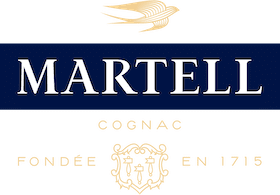Collection
Cocktails
La Maison
Visit Us
How do you taste cognac (like an expert)?

What Does Cognac Taste Like?
Cognac, especially from Maison Martell, is renowned for its rich and complex flavor profile, which can vary significantly depending on its age and blend. Younger Martell cognacs, such as Martell VS, often exhibit vibrant, fruity notes like apricot, plum and candied lemon. As cognac ages, it develops deeper, more mature flavors. Older cognacs like Martell XO offer intricate layers of flavor. Martell XO is characterized by spicy notes of black and pink pepper, rounded out with rich aromas of fig, walnut, and sandalwood. On the palate, it reveals intense notes of fig, red fruit, and blackcurrant bud, leading to an exceptionally long and robust finish. The balance between sweetness, bitterness, acidity, and a subtle salinity makes each sip of Martell cognac a unique and evolving experience.
From wine tasting to cognac
Whether professionally or for pleasure, wine tasting is always a special experience. Yet once one knows a Chardonnay from a Beaujolais, and can discern whether a bottle is oak-barrelled – or corked – where to from there?
The elegant and sophisticated world of cognac just might be the perfect place to apply one’s wine-tasting knowledge and skills, no matter how rudimentary or advanced.
Produced from grapes in the Cognac region, France’s famous amber spirit has much in common with wine. And that extends to the best practices for how to taste cognac too.
What is so special about cognac, is that it is a versatile drink, enjoyed an endless number of ways. If ever asked ‘How do you properly drink cognac?’ or ‘How are you supposed to drink cognac?’, Martell-lovers will know there is only one correct answer: ‘Your Martell, your way’.
That said, there are some fundamental steps to consider that will heighten any tasting experience – whether for cognac, wine, or another drink altogether.
The glass
It starts with the glass. In traditional cognac tasting sessions the spirit is tasted neat, meaning without ice (‘cognac on the rocks’), water, or any other mixer.
Experts will typically reach for a tulip cognac glass, named for its shape. Narrower at the top than the bottom, the tulip glass serves to concentrate and circulate the spirit’s aromas, making them easier to appreciate.
Cognac is also often served in a balloon glass, readily identifiable for its rounded shape or, in other shape of glass. A balloon glass will still allow one to appreciate the cognac’s aromas but, pay attention though to limit its contact with one’s hands, as this will warm the cognac and heighten the sensation of alcohol. The ideal serving temperature for cognac for tasting is 18-20°C.
The eye
What are the colors of cognac? Is cognac light or dark brown?
Cognac can exhibit a range of colors from pale gold to deep amber. In general, younger cognacs, such as Martell VS, often showcase delicate amber with hints of gold, reflecting their relatively shorter aging period. As cognac ages, it tends to take on richer, darker hues due to the prolonged interaction with oak casks. The prestigious Martell L’Or de Jean Martell presents deep, intense amber shades, indicative of its extensive aging process.
These colors result from the interaction between the spirit and the oak casks during aging, where the wood imparts its tannins and color to the cognac. Thus, whether cognac appears light or dark brown depends on its age and the length of time it has spent in the barrel.
Hold the glass by the stem, and lift it to the light. What does the colour tell you? Is the colour a light amber, or darker?
What else can you discern from the clarity? The eaux-de-vie in Martell cognac is produced from clear wines from which all lees have been removed, for a purer, more authentic expression of the vintage and terroir.
The process of double-distillation in the famous alambic charentais copper pot still further improves the clarity of the spirit. By comparison, other brandies such as armagnac are distilled in column stills, resulting in a murkier spirit.
The nose
Time now to engage the olfactory senses. Lift the glass to the nose and gauge the initial aromas. This is called the first nose. If primarily floral or fruity, the cognac may be younger in nature. Older cognacs by contrast develop in intensity.
Swirl the glass to aerate the cognac and release the secondary aromas, then bring to the nose once more. What new aromas can be identified?
Certain cognacs blend hundreds of different eaux-de-vie, some of which may take longer for aromas to emerge. Martell Chanteloup XXO, for example, combines 450 very old eaux-de-vie, offering connoisseurs a complete expression of the very best of Cognac’s terroir.
The palate
The moment for tasting is upon us. By now, having appreciated the tint and aromas of the cognac, the tastebuds will have an inkling of what to expect on the palate.
Sip the cognac and slowly swish it over the tongue and around the palate. Inhale some air while the cognac is in the mouth to unleash the spirit’s full nature. Its flavours will stimulate the receptive palate, conveying the cognac’s unique combination of sweetness, saltiness, acidity and bitterness.
For a true degustation tasting experience, consider pairing cognac with chocolate or, gingerbread or else. A simple square of fine and crunchy dark chocolate, or bitter chocolate with candied orange peel, works particularly well, especially with an XO cognac.
Tasting in order
If tasting multiple cognacs in one sitting, start from youngest to oldest, so as not to overwhelm the palate prematurely.
It is also advisable to discharge the cognac after each mouthful. Contrary to some popular opinion, while swallowing the cognac does not increase your ability to appreciate the cognac, staying sober invariably will!
Please do not share with anyone under 21. Drink responsibly.



















